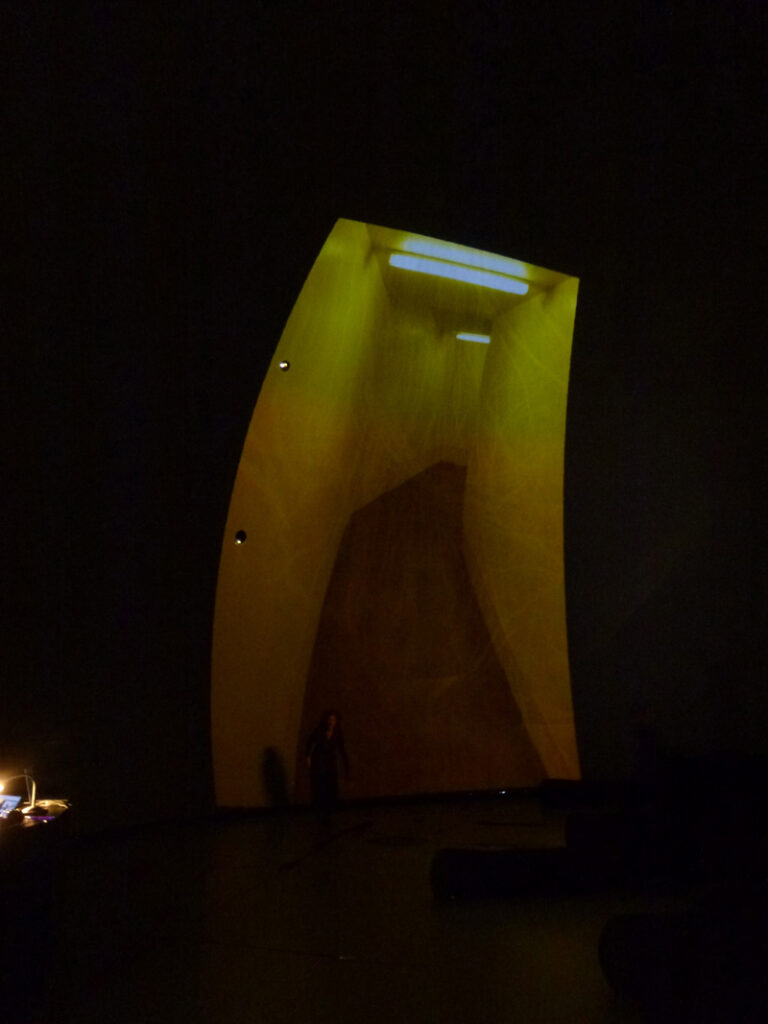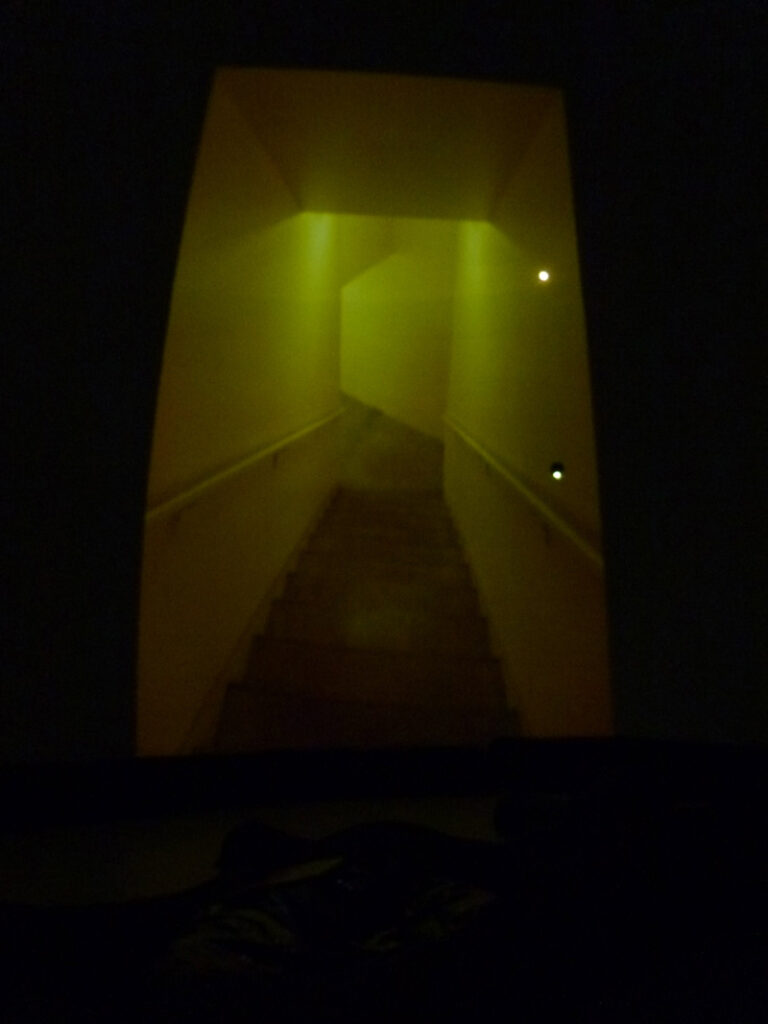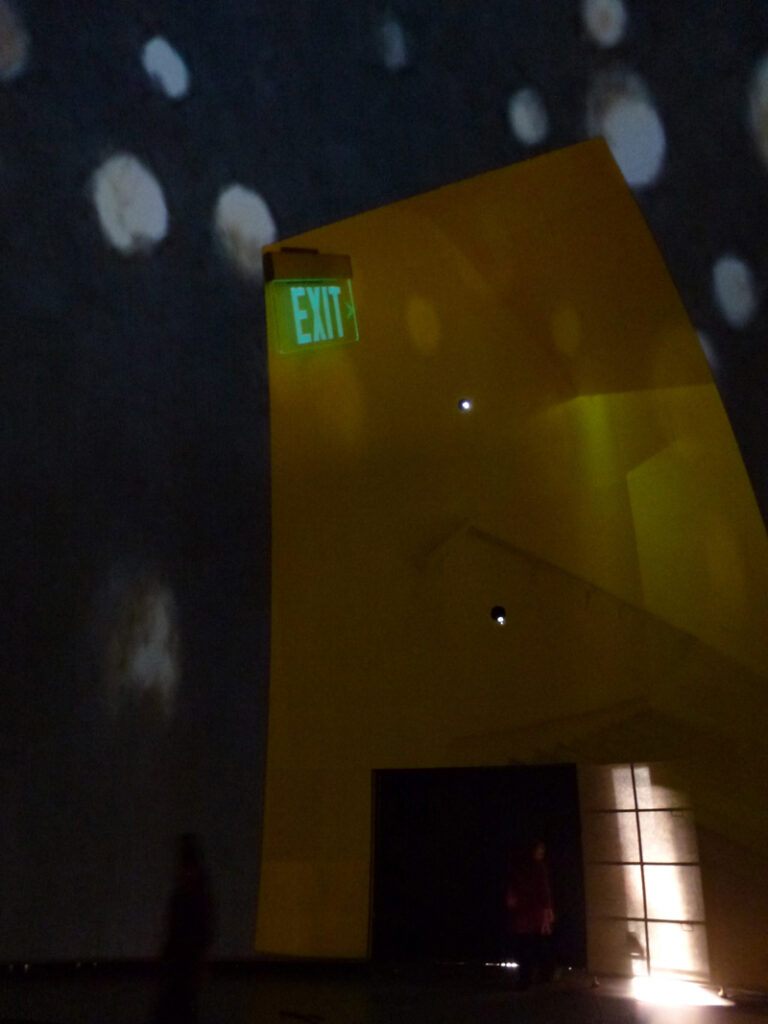The Satosphere at the Society for Arts and Technology in Montreal (SAT) is a technical place; its function is to technically optimise the possibilities of experimenting with experiences of immersion and virtuality. According to the layout of the Satosphere space what is required for such experiences is a homogenous and neutral background for the projected sound and visuals. This is reflected by the dome-shaped interior, which is dark and silent with a circular ground plan that geometrically enhances such homogeneity and neutrality. The spatial layout of the Satosphere, however, calls for a discussion of the ways in which the enclosure and totality of this space conditions the experience of immersion and virtuality. An unambiguously defined space like the Satosphere is a challenge and not necessarily easy to engage with beyond its being an expression of a background for images and visualisations. The interest for addressing these issues has emerged from a desire to bring the Satosphere space into some kind of creative becoming during the Senselab residency Into the Midst, from our experiments to engage processually with this supposedly unaffected space and from my own specific interest in discussing this space for immersion and virtuality through an architectural approach.
Differentiations
Differences need to be in play creatively when a space like the Satosphere affects, determines or even conflicts with the desired experience of immersion. The first set of differences is that between the space, which can be seen as a dome-shaped container, and the experience, which is supposed to become immersive and therefore intensive and processual. With reference to Henri Bergson’s work on multiplicities, the dome-shaped and homogenous space at the SAT belongs to a category of always actualised and quantifiable extensity defined by and differentiated by size and measurements. The Satosphere measures 18 metres in diameter, is 11-13 metres in height and has 8 video projectors and 157 loud speakers1. Experience itself, on the contrary, is a qualitative, heterogeneous multiplicity that continuously differentiates and emerges by actualising aspects of its virtuality2. In this respect, virtuality is part of reality regardless of whether or not advanced technology is involved.
Conditions
In the specific case of the Satosphere, the technology and the dome-shape can be regarded as conditions affecting experience and virtuality; whereas the ‘container-space’ itself, in line with the thinking of Bergson, has no virtuality. The Satosphere’s conditioning of immersion and virtuality works trough delimitations of physical movement – how we move actively or sit passively in the space –, and of what we see and hear. It delimits how and what we experience. All image material intended for projection needs to be edited by specific software or captured by special cameras that prepare the material for being projected onto the dome-shape. The dome-shaped space is a condition that makes us want to homogenize the image material so it fits the shape.

Into the Midst image sequence by Nathaniel Stern and Patrick Lichty.

Into the Midst image sequence by Nathaniel Stern and Patrick Lichty.
Movements
During Into the Midst, our experiments with image and sound projections were carried out with an intention ofmoving; an intention of luring bodies, thought and relations to move. One particular experiment involved 3 photographs of a yellow staircase I had encountered the week before, in a different setting3. These photographs were projected onto the Satosphere surface, which slightly distorted the perspective and enlarged the photographs to a height of approximately 9 meters. The adjustments that had been routinely done before projecting the photographs onto the surface resulted in an added directional diffusion to the original perspective in the photographs of looking down the stairs. Instead, the projection gave an impression of looking up; up into a void diffusely outlined by slightly transparent parts of walls and ceiling. It was recognisable as stairs, but with a different scale that now belonged to the Satosphere and not to a moving body descending the stairs. So, by becoming part of the Satosphere’s space a perspectival ambiguity were added to the images and the enlargement of the images removed the possibility of an immediate correspondence between the human body and the stairs. By detaching the images from the human body in regards to both perspective and size the projection process seemed to increase the experience of the Satosphere as a place that primarily addresses movements of thoughts and vision. The immediate perception of the projected stairs, however, could touch on an understanding of ‘moving down stairs’ and contain our experiences of moving down any stairs.

Into the Midst image sequence by Nathaniel Stern and Patrick Lichty.
One of the images from this experiment (illustration 3) shows a projection on the part of the Satosphere where people enter from the foyer and the restaurant. The entrance is normally completely covered by a black fabric: in order to obtain the desired darkness and homogeneity no daylight is let in and any visual or sound contact to the outside is a disturbance. For a moment, a part of the entrance is not fully covered by the black fabric and a bright light from the foyer and restaurant space outside lights up the dome wall. This immersion of the Satosphere into real life and real time negates the homogenized space and it points towards the potential of regarding the threshold as a ‘passage between’ as opposed to the outline of a ‘container’. The passage consists of many layers that fade into each other: the light and the cloth fades into the projection sequence, which is itself layered by images that fade into each other. And the projection surface reveals traces of its physical presence by the two small projectors – regardless of the contents of the image.
Unforeseen differentiations.
Notes
[1] http://www.sat.qc.ca
[2] See: Deleuze, Gilles: Bergsonism. New York: Zone Books, 1988.
[3] In the Museum of Contemporary Art, Cleveland, Ohio. The museum was inaugurated a few days prior to my visit, in October 2012, and is designed by Farshid Moussavi Architects. The yellow staircase at MOCA embodies a fascinating in-between of architecture and art, being an emergency exit as well as exhibition space for sound art. The experience of a surprise.
